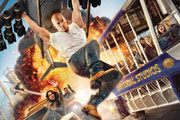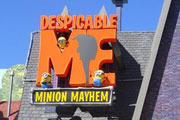Who doesn't love the heart-pounding, facts-paced thrills of a roller coaster ride? Half the fun of the ride comes from feeling like you're going to fly right out of your seat - so why don't you? Read on to learn why taking a ride in a crazy coaster is about as dangerous as knitting with your grandma.
Up, Up and Away
A motorized chain pulls the roller coaster to the top of the first hill (that's why you hear that click, click, click sound). The first hill is always the tallest one unless the coaster has more motorized chains later on (listen for more clicking), which means that the first hill has the largest large amount of gravitational potential energy. What's that? It's the amount of work an object will be able to do with the energy it builds up from falling. The energy the roller coaster builds up from falling down that first hill will be enough to take you all the way to the end of the ride!

Accelerating Adrenalin
Now that the roller coaster has made it to the top of the first hill, gravity takes over. When the roller coaster goes down the hill, it speeds up at a rate of 32.15 feet (9.8 meters) per second squared. As it accelerates down the hill, the potential energy gets converted to kinetic energy. Kinetic energy is motion energy. Simply put, the energy changes from stored energy to moving energy. The weight of the roller coaster is pulled down by gravity (which means it's falling).

Newton's Law of Roller Coasters
Sir Isaac Newton (the dude who explained gravity) figured out the concept of inertia. No, inertia isn't a new game from EA, it's the law of physics that says that any object in motion will stay in motion until acted on by an equal but opposite force. When the roller coaster is at the bottom of the first hill, the kinetic energy is at it's biggest. Now that the coaster is whipping around loops and other hills, its energy is being lost to other forces like friction (energy created by two things being rubbed together) and air resistance. By the time the roller coaster gets to the end of the ride it has lost enough energy to come to a stop (usually with a little help from the brakes).
 Courtesy of ExplainthatStuff
Courtesy of ExplainthatStuff
Please Stay Seated Until the End of the Ride
On some parts of this wild ride it feels like you're being pushed down, even though some of the time you're being pushed up. When you go down the hill the seatbelt or safety bars pull you down with the coaster. When you get to the bottom, you're still moving downwards but the coaster starts pushing you up again. The combination of these two forces holds you comfortably in your seat.

Related Stories:

































